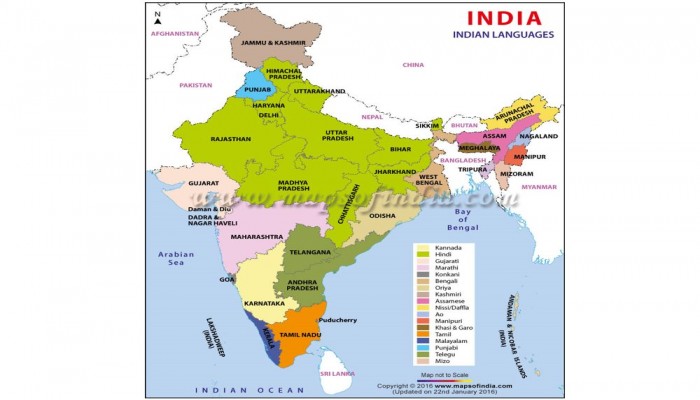Importance of the Indian Linguistic Area and its implications on the Aryan Migration/Invasion Theory
- In History & Culture
- 01:25 PM, May 10, 2017
- Avatans Kumar
India is a multilingual society. According to the 1961 census, there were 1,652 languages in India. For these many languages to exist and to survive the test of time, there needs to be a cohesively conducive environment. And there isn’t a better ingredient of such an environment than a prolonged era of relative peace and tranquility. Believe it or not, despite the epic Mahabharata war, the brutal Islamic invasion, and an encumbering and destabilizing partition, India has been fortunate to have a history of relative peace and tranquility compared to many other parts of the world. This is evident in many facets of the Indian civilization, none better than in its languages. Through the process known as ‘contact’ and ‘convergence’, the languages of India that happen to belong to distinct linguistic families have created something of a linguistic melting pot – a melting pot where divergent linguistic identities merge and give rise to unique features. One of these features is when in a geographically contiguous area, such as the Indian sub-continent, languages belonging to more than one family start to show “traits in common which are found not to belong to other members of (at least) one of the families.” M. B. Emenau calls such geographically contiguous area as a Linguistic Area, and linguists describe India as one such Area.
The concept of Indian Linguistic Area, though predicated around languages, may have ramifications beyond it. One such area could be the notion of the historically dominant but now debunked Aryan Migration/Aryan Invasion Theory. The importance of the concept of Linguistic Area, vis-à-vis Aryan Migration/Aryan Invasion Theory (henceforth, AMT/AIT), seems to be borne out of the fact that it is in direct conflict with the postulates of AMT/AIT, which until recently has been the dominant paradigm of our historical, cultural, as well as political discourse. So, before we discuss some of the salient features of the Indian Linguistic Area, let us take a quick look at AMT/AIT.
The Aryan Migration Theory assumes that the Aryans were the original inhabitants of Central Asia and came to India in waves via its northwestern boarders. However, recent advances in science, most notably in genetics have shed some light on the subject of migration (or non-migration) of Aryans in the Indian sub-continent. A group of scientists concluded in their 2006 study that the influence of Central Asia on the pre-existing gene pool in India was “minor”. Their study further suggests that there has not been any significant change in the South Asian genetic pool in at least 10,000-15,000 years. The study also claims that the genetic data is “more consistent with a peninsular origin of Dravidian speakers than a source with proximity to the Indus.”
On the other hand, the Aryan Invasion Theory assumes that the Aryans were fierce nomadic fighters who came to India and decimated the highly advanced native (the Indus Valley) civilization. Word Arya finds mention in several Vedic literatures. However, most Indic scholars, such as Max Muller and David Frawley, are of the opinion that Vedic Arya has nothing to do with race. Term Arya in fact means “noble” or “spiritual” and has been used as such by the “Buddhists, Jains, and Zoroastrians as well as Hindus” (Frawley). Many Indic scholars also believe that AIT/AIM is nothing but a figment of imagination cooked up by the European colonialists and later on perpetuated by the Marxist historians. N. S. Rajaram writes that “the idea of Aryans as foreigner who invaded India and destroyed the existing Harappan Civilization is a modern European invention; it receives no support whatsoever from Indian records – literary or archaeological”. Historical linguist Hans Hock calls the Aryan Invasion Theory “so 19th century … it reeks of the whole idea of nations invading other nations, subjugating them … is a fairly recent development in human history … to back project a 19th century ideology of Western colonial empires on to pre-history somewhere may be in the 2nd millennium BC seems to be totally anachronistic.” Also, scientific and archaeological evidence show no signs of any major armed conflict. In fact archaeologists, such as B.B. Lal, consider Vedic and Harappan civilization as the literary and material facets of the same civilization. Further, recent studies have pointed towards climate change as the most viable reasons for the decline of the Harappan (or Indus-Saraswati Valley) Civilization, not wars.
With such developments, the focus should now shift towards co-existence, contact, and convergence, away from the narratives of migration and conflict. This is where the notion of Indian Linguistic Area comes into picture. Linguistic Area, as mentioned earlier, is a convergence phenomenon, a sort of diffusion of linguistic traits across the genetic boundaries amongst multiple language families. In a multilingual context, speakers change the way they use their language at many levels because of the influence of the speakers of the other languages they come into contact. If this situation persists for a prolonged period, distinct languages become similar to each other. This change may occur at levels including vocabulary, sound system, syntactic or grammatical structures, etc. In this process of assimilation, they gain some of the features that are not part of their linguistic DNA. So for example, most Indian languages are marked by the absence of a system of prepositions. They, in stead, have postpositions. For example, one would say mez ke upar (above the table) in Hindi. Here, as we can see, ke upar comes after the noun mez (hence, postposition) as opposed to English where ‘above’ comes before the noun ‘table’. It is evident from this example that despite being genetically related (proto-Indo-European), the two languages Hindi and English differ with each other in terms of this linguistic feature. But the important fact to note here is that this feature of postposition is shared among may unrelated languages of South Asia.
Indian Linguistic Area is characterized by at least 4 major language families. They include (1) Indio-Aryan, (2) Dravidian, (3) Tibeto-Burman, and (4) Austro-Asiatic (or Munda). Indo-Aryan languages include Sanskrit, Hindi, Marathi, etc. These languages are spoken mostly in the north, and northwestern parts of India. Tamil, Kannada, Telugu, etc., are Dravidian languages and are spoken in the peninsular south. Tibeto-Burman languages include Naga, Meitei, etc. and their concentration is primarily in the North-East of India. Munda languages include Kharia, Mundari, Ho, Santhali, etc. Most of the Munda languages are spoken in the Chotanagpur region. However, in their spread as language islands throughout the country they are surrounded by either Indo-Aryan or Dravidian languages. Language contact and multilingualism is an important feature of the Indian subcontinent. Multilingualism in this part of the globe is the norm, which is characterized by a shared history and contact of thousands of years. Borrowing of words across languages is quite common as it is probably the easiest of all linguistic features to notice. So, it is quite common to find Sanskrit (Indo-Aryan) words in the members of other languages families of India. However, there are several other features of the languages of the Indian sub-continent that can only be explained in terms of long-term peaceful coexistence in a Linguistic Area which has given rise to conflicting yet distinct and pan-Indian linguistic patterns within the diverse language families of India. Some of the features of Indian Linguistic Area include SOV word order, retroflex sounds, and ‘reduplication’.
With some minor exceptions (Khasi, for example), most Indian languages, cutting across language families, have SOV word order. This means, in sentence formation, the Subject, the Object, and the Verb appear in that order. For examples, in Hindi,
Ram-ne Sita ko kalam di.
Ram to Sita pen gave
Ram gave a pen to Sita.
Similarly, in Kannada.
Naanu mane kattidenu
I the home built
I built the house.
Point to notice here is that genetically related (proto Indo-European) languages of Hindi outside the Indian Linguistics area are mostly characterized by SVO word order. For example, see the English translation of Hindi and Kannada sentences.
Similarly, the hard retroflex sounds like t- in tamatar (Hindi, or tomato in English) and voiceless aspirated sounds (if you put your palm close to your mouth, you can feel a warm puff of air coming out) like kh (as in Hindi khana, or food in English), and ph (as in Hindi phal, or fruit in English) are commons features among most Indian languages. These sounds are so widespread that they can be found “even in those languages that were isolated for thousands of years, e.g. Andamanese’, notes linguist Anvita Abbi. Once again, for contrast, English does not have either of these two sounds.
Another Indian Linguistic Area feature is ‘reduplication’, which refers to a complete or partial repetition of a base word. Once again, this feature appears in almost all Indian languages regardless of their genetic affiliation. For example, ghar-ghar (every house, Hindi), and chinna-chinna (teeny weany or very tiny, Tamil). Notice here that such words are formed by fully (or partially) repeating a base word. However, the newly ‘reduplicated’ word has a slightly different meaning.
Research on Indian Linguistic areas has revealed several similar features found across linguistic families. In recent past linguist Anvita Abbi has extensively researched several features of Indian Linguistic Area and has published her findings in numerous books and articles. It is evident from the above discussion that the notion of an Indian Linguistic Area is the perfect antidote of the now debunked AIT/AMT. However, it is unfortunate that the features of the Indian Linguistic Area have barely been highlighted. In its place, the plurality of languages has been used by the vested interests for narrow political gains as well as for fomenting violence and unrest leading to weakening and unsettling of the social fabric in India. The Aryan vs. Dravidian and tribal vs. non-tribal controversy has been the hallmark of identity politics in India whereas the Linguistic Area convergence features have been totally overlooked. It is time we recognize and highlight these features and bid adieu to all divisive narratives.
Footnotes & References:
https://www.scientificamerican.com/article/200-year-drought-doomed-indus-valley-civilization/
Image Credit: https://www.mapsofindia.com/culture/indian-languages.html







Comments